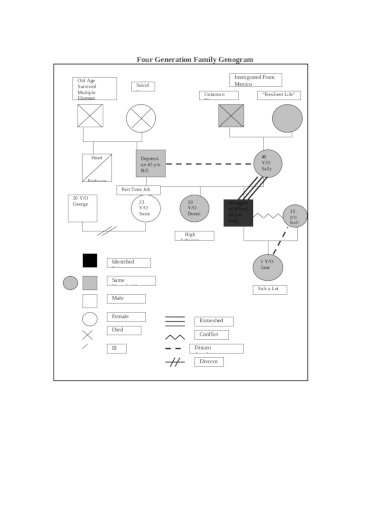

Is there any relationship / contact with his maternal aunt (Eve)?.Who does he see as his grandparents – Grace and James or Grace and Simeon?.Does he have a relationship with his father?.If we consider Harry in the example above, the following questions are not answered: With what are termed “ blended families” on the increase, genograms do not tell us about the amount of contact that there is between family members, or who is important to the child (i.e. Whilst providing a useful summary of the family relationships, genograms do not tell about the dynamics in the home and wider family. ages / dates of birth / year or date of death / etc.) as this adds more context. Record as much as you can in terms of additional information (e.g.It doesn’t have to just be in black and white, it may be useful to add colours to identify specific family groups within the genogram.This allows you to keep track of change over time. Date when the original genogram was completed and when any subsequent information is added.Ensure that you use a large piece of paper – on many occasions an A3 sheet may be necessary due to the complexities of family dynamics.A quick access guide that you can print for ease of reference can be found at the bottom of the page. You can therefore see that there is a lot of information that can be stored for quick access using a genogram. Initially, it may look confusing, however let’s break it down and look at what the individual parts of the genogram are telling us. Click on the image to see a larger version. Females are represented by circles, males by squares. Each line in the genogram represents a generation, with all the children on the bottom line, the parent’s generation above them and the grandparent’s generation at the top of the diagram. Through working with him you have established who the adults are in his immediate family, going back to his mother’s parents. Harry (represented by the green block) is a pupil at your school. Norton and Company Inc.)īy creating and using genograms and ecomaps with children you can establish a lot about the context the child or young person is living in, who is important to them and who may have parental responsibility. A genogram offers the clinician a basic picture of who clients are, where they come from, and who matters in their lives.

Simply put, a genogram is a map of who you belong to. Hathaway press, SJ New Hampshire, 1992 The Basic Genogram Symbols Male: Female: Birth Date Age inside symbol Death Date Death X 8-10-’41 10-4-2001. McGoldrick (2016) describes a genogram as:
BASIC GENOGRAM HOW TO
Genograms use a common set of symbols, and in this post we look at how to use these to construct and read a genogram. By creating and using genograms and ecomaps with children you can establish a lot about the context the child or young person is living in, who is important to them and who may have parental responsibility. Remember, it is equally important to include what you do not know about your family in addition to what you do know. Create a genogram based on your family by following the basic genogram guidelines listed in Chapter 2. This assignment meets the following CACREP Standards:ĥ.F.2.b.A genogram is another way of describing a family tree and can be useful for establishing who is living in the home and who is in the wider family network, and whether there is contact or not. Create a genogram based on your family by following the basic genogram guidelines. Refer to the directions in the Student Success Center. You are required to submit this assignment to LopesWrite. Please review the rubric prior to beginning the assignment to become familiar with the expectations for successful completion. While APA style is not required for the body of this assignment, solid academic writing is expected, and documentation of sources should be presented using APA formatting guidelines, which can be found in the APA Style Guide, located in the Student Success Center.

Submit your genogram and essay to your instructor for review. Include a minimum of three scholarly resources to support your essay. Be sure to address each of the eight elements s listed above in your genogram and essay.

Write a 750-1,000-word essay describing your observations of what was noticed from the genogram process. Remember, it is equally important to include what you do not know about your family in addition to what you do know.īe sure to identify the following in your genogram: Create a genogram based on your family by following the basic genogram guidelinesĬreate a genogram based on your family by following the basic genogram guidelines listed in Chapter 2.


 0 kommentar(er)
0 kommentar(er)
